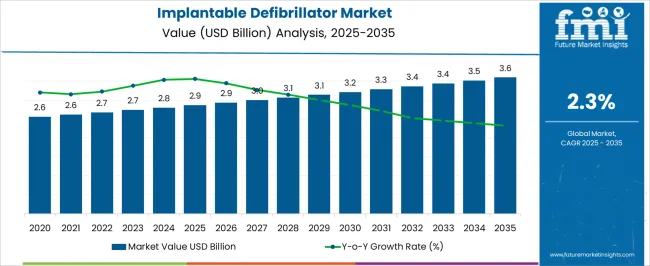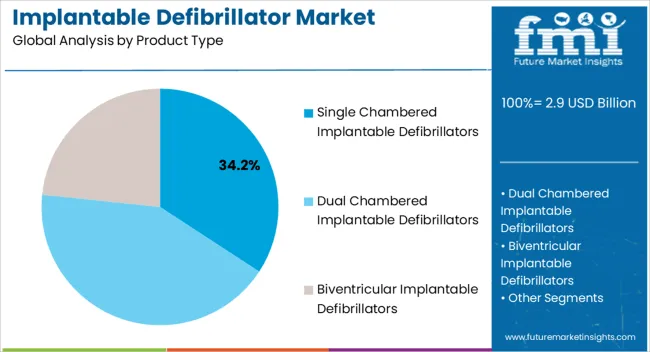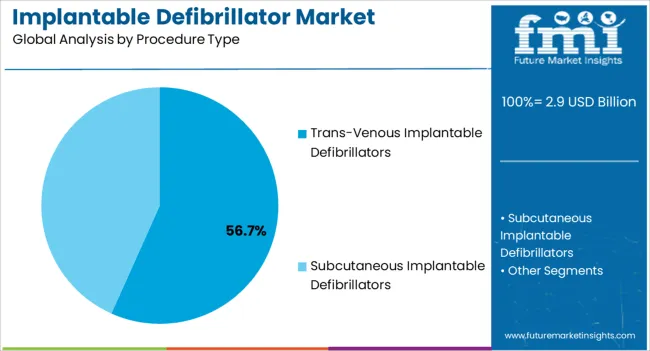The Implantable Defibrillator Market is estimated to be valued at USD 2.9 billion in 2025 and is projected to reach USD 3.6 billion by 2035, registering a compound annual growth rate (CAGR) of 2.3% over the forecast period.

| Metric | Value |
|---|---|
| Implantable Defibrillator Market Estimated Value in (2025 E) | USD 2.9 billion |
| Implantable Defibrillator Market Forecast Value in (2035 F) | USD 3.6 billion |
| Forecast CAGR (2025 to 2035) | 2.3% |
The implantable defibrillator market is experiencing strong growth driven by increasing prevalence of cardiovascular disorders, rising incidence of sudden cardiac arrest, and growing awareness regarding early intervention for heart rhythm abnormalities. Advanced implantable devices are being adopted to reduce mortality rates and improve patient quality of life, particularly among high-risk cardiac patients. The market is further supported by technological innovations, including miniaturized devices, enhanced battery longevity, and improved software for arrhythmia detection and therapy customization.
Hospitals and cardiac care centers are increasingly prioritizing minimally invasive implantation procedures and devices with higher safety and reliability standards. Regulatory approvals and reimbursement policies in key regions are facilitating broader access to these devices, expanding the patient base.
As cardiovascular disease prevalence continues to rise globally and healthcare infrastructure improves in both developed and emerging markets, the implantable defibrillator market is positioned for sustained growth The focus on patient-centric solutions, remote monitoring capabilities, and integration with digital health platforms is expected to drive innovation and adoption in the coming decade.
The implantable defibrillator market is segmented by product type, procedure type, end user, and geographic regions. By product type, implantable defibrillator market is divided into Single Chambered Implantable Defibrillators, Dual Chambered Implantable Defibrillators, and Biventricular Implantable Defibrillators. In terms of procedure type, implantable defibrillator market is classified into Trans-Venous Implantable Defibrillators and Subcutaneous Implantable Defibrillators. Based on end user, implantable defibrillator market is segmented into Hospitals, Specialty Clinics, and Ambulatory Surgical Centers. Regionally, the implantable defibrillator industry is classified into North America, Latin America, Western Europe, Eastern Europe, Balkan & Baltic Countries, Russia & Belarus, Central Asia, East Asia, South Asia & Pacific, and the Middle East & Africa.

The single chambered implantable defibrillators segment is projected to hold 34.2% of the implantable defibrillator market revenue share in 2025, establishing it as the leading product type. This dominance is being driven by the device’s simpler design, reliability, and cost-effectiveness, which makes it suitable for a wide range of patients requiring ventricular arrhythmia management.
The single chambered configuration allows for targeted therapy delivery while reducing procedural complexity and potential complications during implantation. The segment is benefiting from increasing adoption in hospitals and cardiac care centers that prioritize patient safety and efficiency in device management.
Additionally, improvements in battery longevity and device programmability are enhancing long-term patient outcomes, reinforcing preference for this product type Manufacturers are focusing on producing compact and versatile devices capable of integrating with remote monitoring systems, which further supports adoption and strengthens the market share of single chambered implantable defibrillators globally.

The trans-venous implantable defibrillators segment is anticipated to account for 56.7% of the implantable defibrillator market revenue share in 2025, making it the leading procedure type. Its adoption is being reinforced by clinical reliability and extensive physician familiarity with the trans-venous implantation approach, which enables direct access to cardiac chambers for effective arrhythmia management.
The segment benefits from the ability to provide continuous monitoring and therapy delivery while minimizing device-related complications when implanted by experienced cardiac specialists. Rising hospital infrastructure development, increasing availability of trained electrophysiologists, and procedural standardization in advanced healthcare systems are further driving adoption.
Continuous improvements in lead technology, device programmability, and patient monitoring software are enhancing clinical outcomes and long-term device performance As sudden cardiac arrest incidence increases globally, the trans-venous implantable defibrillator procedure continues to dominate due to its effectiveness, proven safety record, and integration with digital health platforms.

The hospitals end-use segment is expected to hold 41.8% of the implantable defibrillator market revenue share in 2025, establishing it as the leading end-user category. Its leadership is being driven by the availability of specialized cardiac care infrastructure, trained electrophysiologists, and established procedural protocols for device implantation.
Hospitals are increasingly investing in state-of-the-art cardiac intervention technologies, including advanced implantable defibrillators with remote monitoring capabilities, to enhance patient outcomes and reduce post-operative complications. The segment is also being supported by rising healthcare expenditure and reimbursement coverage for device-based cardiac therapies, enabling wider patient access.
Adoption is further encouraged by hospitals’ ability to manage follow-up care, device programming, and maintenance efficiently, ensuring patient safety and compliance with clinical standards Growing prevalence of cardiovascular disorders, coupled with the focus on early intervention and life-saving treatments in hospital settings, continues to position this segment as the largest revenue contributor in the implantable defibrillator market globally.
The global implantable defibrillator market is witnessing several significant trends. Technological advancements are driving the development tiwards more efficient, compact, and user-friendly devices. Innovations such as wireless communication and remote monitoring capabilities are becoming standard, enhancing patient management and outcomes. This is fueling the sales of implantable defibrillators.
A growing emphasis on minimally invasive procedures is increasing the adoption of subcutaneous implantable defibrillators (S-ICDs) over traditional transvenous systems. Growing healthcare infrastructure and improved access to advanced medical devices in emerging sectors are likely to contribute to the sales of implantable defibrillators.
Supportive government policies and rising healthcare expenditures are also likely to play crucial roles in driving demand for implantable defibrillators. The expansion of telehealth services will facilitate better patient management and monitoring, increasing the adoption of implantable defibrillators.

| Country | CAGR |
|---|---|
| China | 3.1% |
| India | 2.9% |
| Germany | 2.6% |
| France | 2.4% |
| U.K. | 2.2% |
| U.S. | 2.0% |
| Brazil | 1.7% |
The Implantable Defibrillator Market is expected to register a CAGR of 2.3% during the forecast period, exhibiting varied country level momentum. China leads with the highest CAGR of 3.1%, followed by India at 2.9%. Developed markets such as Germany, France, and the U.K. continue to expand steadily, while the U.S. is likely to grow at consistent rates. Brazil posts the lowest CAGR at 1.7%, yet still underscores a broadly positive trajectory for the global Implantable Defibrillator Market. In 2024, Germany held a dominant revenue in the Western Europe market and is expected to grow with a CAGR of 2.6%. The U.S. Implantable Defibrillator Market is estimated to be valued at USD 1.1 billion in 2025 and is anticipated to reach a valuation of USD 1.3 billion by 2035. Sales are projected to rise at a CAGR of 2.0% over the forecast period between 2025 and 2035. While Japan and South Korea markets are estimated to be valued at USD 152.6 million and USD 83.9 million respectively in 2025.

| Item | Value |
|---|---|
| Quantitative Units | USD 2.9 Billion |
| Product Type | Single Chambered Implantable Defibrillators, Dual Chambered Implantable Defibrillators, and Biventricular Implantable Defibrillators |
| Procedure Type | Trans-Venous Implantable Defibrillators and Subcutaneous Implantable Defibrillators |
| End User | Hospitals, Specialty Clinics, and Ambulatory Surgical Centers |
| Regions Covered | North America, Europe, Asia-Pacific, Latin America, Middle East & Africa |
| Country Covered | United States, Canada, Germany, France, United Kingdom, China, Japan, India, Brazil, South Africa |
| Key Companies Profiled | Medtronic, Boston Scientific Corporation, Abbott, BIOTRONIK SE & Co. KG, MicroPort Scientific Corporation, and LivaNova PLC |
The global implantable defibrillator market is estimated to be valued at USD 2.9 billion in 2025.
The market size for the implantable defibrillator market is projected to reach USD 3.6 billion by 2035.
The implantable defibrillator market is expected to grow at a 2.3% CAGR between 2025 and 2035.
The key product types in implantable defibrillator market are single chambered implantable defibrillators, dual chambered implantable defibrillators and biventricular implantable defibrillators.
In terms of procedure type, trans-venous implantable defibrillators segment to command 56.7% share in the implantable defibrillator market in 2025.






Our Research Products

The "Full Research Suite" delivers actionable market intel, deep dives on markets or technologies, so clients act faster, cut risk, and unlock growth.

The Leaderboard benchmarks and ranks top vendors, classifying them as Established Leaders, Leading Challengers, or Disruptors & Challengers.

Locates where complements amplify value and substitutes erode it, forecasting net impact by horizon

We deliver granular, decision-grade intel: market sizing, 5-year forecasts, pricing, adoption, usage, revenue, and operational KPIs—plus competitor tracking, regulation, and value chains—across 60 countries broadly.

Spot the shifts before they hit your P&L. We track inflection points, adoption curves, pricing moves, and ecosystem plays to show where demand is heading, why it is changing, and what to do next across high-growth markets and disruptive tech

Real-time reads of user behavior. We track shifting priorities, perceptions of today’s and next-gen services, and provider experience, then pace how fast tech moves from trial to adoption, blending buyer, consumer, and channel inputs with social signals (#WhySwitch, #UX).

Partner with our analyst team to build a custom report designed around your business priorities. From analysing market trends to assessing competitors or crafting bespoke datasets, we tailor insights to your needs.
Supplier Intelligence
Discovery & Profiling
Capacity & Footprint
Performance & Risk
Compliance & Governance
Commercial Readiness
Who Supplies Whom
Scorecards & Shortlists
Playbooks & Docs
Category Intelligence
Definition & Scope
Demand & Use Cases
Cost Drivers
Market Structure
Supply Chain Map
Trade & Policy
Operating Norms
Deliverables
Buyer Intelligence
Account Basics
Spend & Scope
Procurement Model
Vendor Requirements
Terms & Policies
Entry Strategy
Pain Points & Triggers
Outputs
Pricing Analysis
Benchmarks
Trends
Should-Cost
Indexation
Landed Cost
Commercial Terms
Deliverables
Brand Analysis
Positioning & Value Prop
Share & Presence
Customer Evidence
Go-to-Market
Digital & Reputation
Compliance & Trust
KPIs & Gaps
Outputs
Full Research Suite comprises of:
Market outlook & trends analysis
Interviews & case studies
Strategic recommendations
Vendor profiles & capabilities analysis
5-year forecasts
8 regions and 60+ country-level data splits
Market segment data splits
12 months of continuous data updates
DELIVERED AS:
PDF EXCEL ONLINE
Subcutaneous Implantable Defibrillator System Market Size and Share Forecast Outlook 2025 to 2035
Subcutaneous Implantable Defibrillator (S-ICD) Market is segmented by product, indication, and end user from 2025 to 2035
Implantable Tibial Neuromodulation Market Forecast and Outlook 2025 to 2035
Implantable Collamer Lens Market Size and Share Forecast Outlook 2025 to 2035
Implantable Infusion Pump Market Size and Share Forecast Outlook 2025 to 2035
Implantable Drug Eluting Devices Market Size and Share Forecast Outlook 2025 to 2035
Implantable Drug Infusion Pumps Market
Defibrillator Analyzers Market Size and Share Forecast Outlook 2025 to 2035
Wearable Defibrillator Patch Market Analysis - Size, Share, and Forecast Outlook 2025 to 2035
External Defibrillators Market Size and Share Forecast Outlook 2025 to 2035
MRI Safe Defibrillator Market
Automated External Defibrillator Market Analysis – Size, Share, and Forecast 2025 to 2035
Wearable Cardioverter Defibrillator Market Size and Share Forecast Outlook 2025 to 2035

Thank you!
You will receive an email from our Business Development Manager. Please be sure to check your SPAM/JUNK folder too.
Chat With
MaRIA